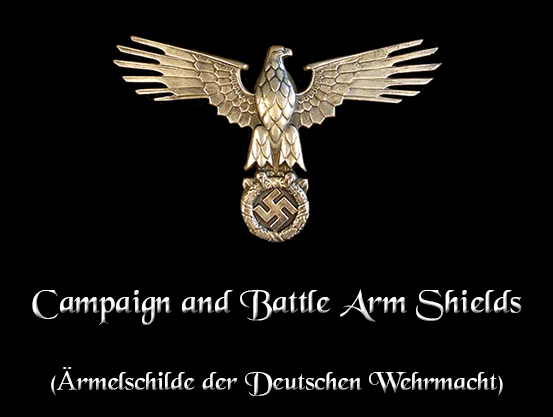

The Narvik Campaign Shield
(Der Narvikschild)
The Narvik Shield (Narvikschild) was designed by Professor Dr Richard Klein of Munich, and instituted on the 19th August 1940 by Adolf Hitler with the decree published in "Reichsgesetzblatt" (Number 154) on the 28th August for the army, followed on the 12th and 13th of September for the navy and air force respectively.
The first award was made to Generaloberst Eduard Dietl by Adolf Hitler on 21 March, 1941. A total of 8,577 shields were presented.
Heer (army): total 2,755
Luftwaffe (airforce): total 2,161
Kriegsmarine (navy): 3,661
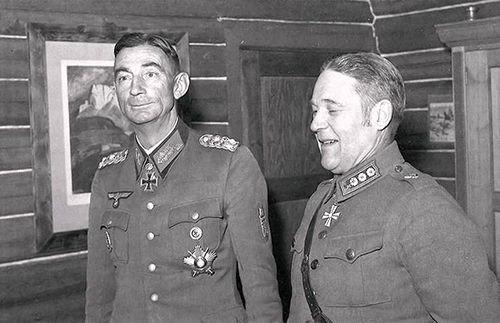
Generaloberst Eduard Dietl with the Narvik Shield in wear
Award Criteria
The shield was awarded to all German forces that took part in the battles of Narvik between the 9th April and 8th June, 1940.
Versions
Silver shield on field-gray wool backing for Heer (army)
Silver shield on gray-blue wool backing for Luftwaffe (air force)
Gilded shield on dark blue wool backing for Kriegsmarine (navy)
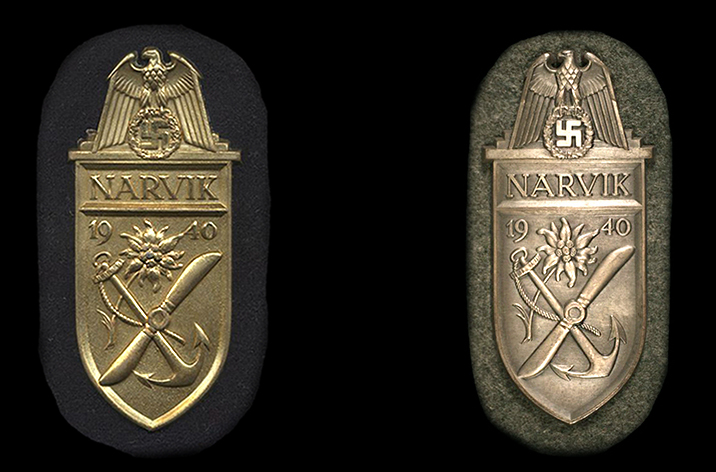
Narvik Campaign Shield - left: Kriegsmarine (Navy) right: Heer (Army)
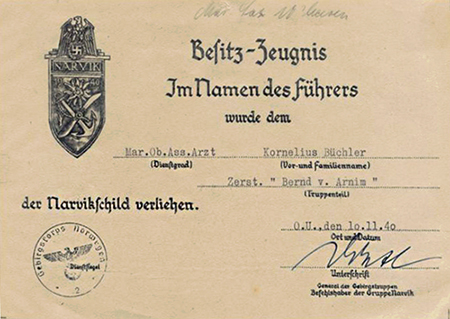
Document for the Narvik Campaign Shield
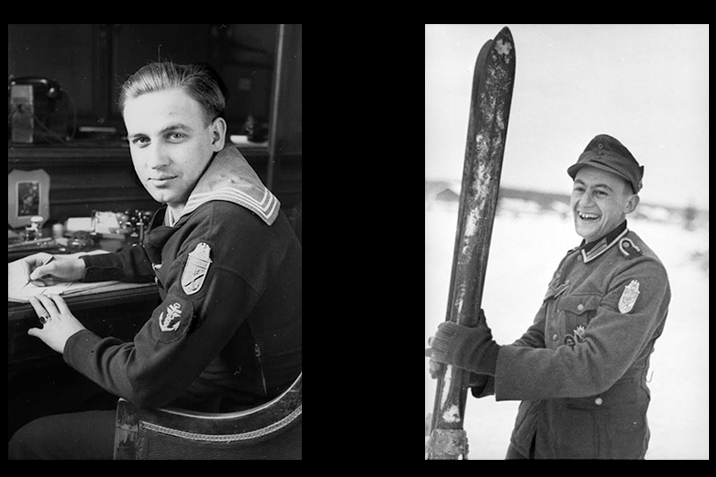
Narvik Campaign Shield in wear - left: Kriegsmarine (navy) right: Heer (army)
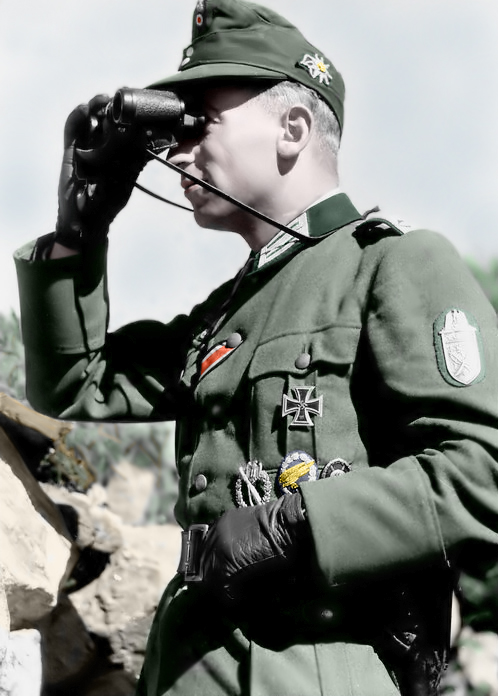
officer with Narvik Shield in wear
![]()
The Cholm Battle Shield
(Der Cholmschild)
After the relief of Cholm, a design for the Cholm Battle Shield (Cholmschild) was produced by Generalleutnant Theodor Scherer and Polizei-Rottwachtmeister Schlimmer and instituted on the 1st July 1942 for award to those who fought in the Cholm Pocket between the 21st January and 5th May 1942.
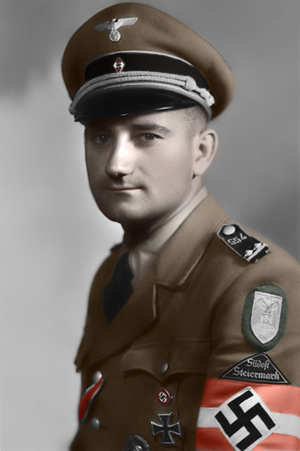
A member of the Hitler-Jugend with Cholm Battle Shield in wear
Award Criteria
Having served honourably within the Cholm Pocket between the 21st January and 5th May 1942.
Having been wounded in the campaign
Having flown and landed at the airfield within the pocket
Versions
Shield on field-gray wool backing for Heer (army) and Waffen-SS
Shield on gray-blue wool backing for Luftwaffe (air force)
Shield on black wool backing for Panzer units (armoured units)
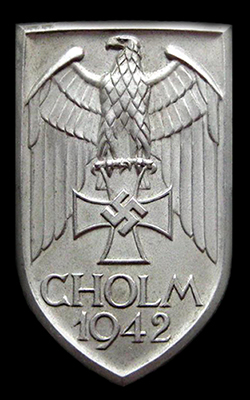
The Cholm Battle Shield
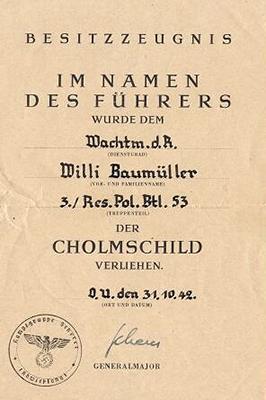
Document for the Cholm Battle Shield
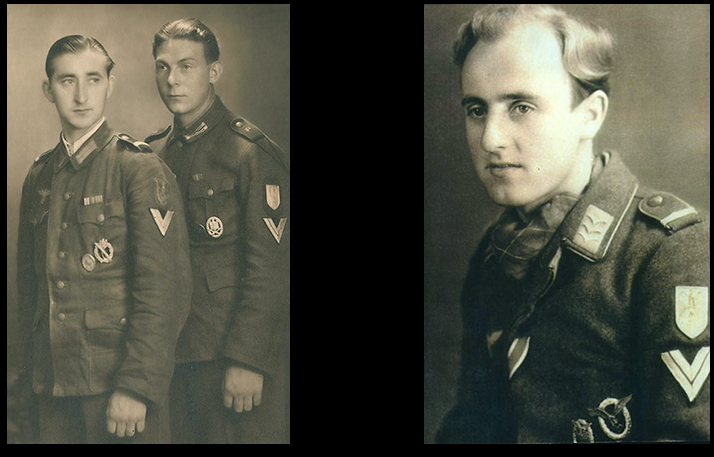
Cholm Battle Shield in wear - left: Heer (army) right: Luftwaffe (airforce)
![]()
The Crimea Campaign Shield
(Der Krimschild)
The Crimea Shield (Krimschild) was instituted on the 25th July 1942 and awarded to military personnel under the command of Generalfeldmarschall Erich von Manstein who fought against Soviet Russian forces and captured the Crimea region (Krim) between 21st September 1941 and 4th July 1942. As well as the German forces, the shield was also awarded to soldiers of the Romanian Armed Forces who participated in the Crimea campaign.
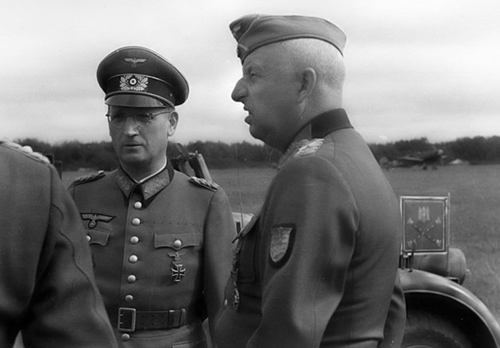
Generalfeldmarschall Erich von Manstein with the Crimea (Krim) Shield in wear
Award Criteria
Participation in one or more of the following battles
1.Breakthrough Battle of Perekop (21st to 30th September 1941)
2.Breakthrough Battle of Juschun (18th to 27th October 1941)
3.Crimean follow-up battles, breakthrough at Kerch (28th October to 16th November 1941)
4.First attack on Sevastopol (17th to 31st December 1941)
5.Battle of Feodosiya (15th to 18th January 1942)
6.Defensive battles at Parpach (19th January to 7th May 1942)
7.Reconquest of the Kerch Peninsula (8th to 21st May 1942)
8.Second attack on Sevastopol (7th June to 4th July 1942)
Wounded in action
Continuous three-month service south of the line Genischesk - Salkowo - Perekop
Versions
Shield on field-gray wool backing for Heer (army) and Waffen-SS
Shield on gray-blue wool backing for Luftwaffe (air force)
Shield on black wool backing for Panzer units (armoured units)
Shield on dark blue wool backing for Kriegsmarine (navy)

Crimea (Krim) Shield - Kriegsmarine (navy)
(Jody Beltram collection)
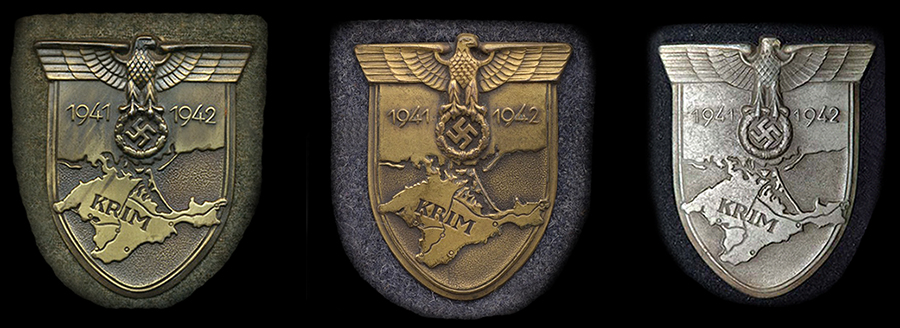
The Crimea Campaign Shield - left: Heer (army) middle: Luftwaffe (airforce) right: Panzer (armoured units)
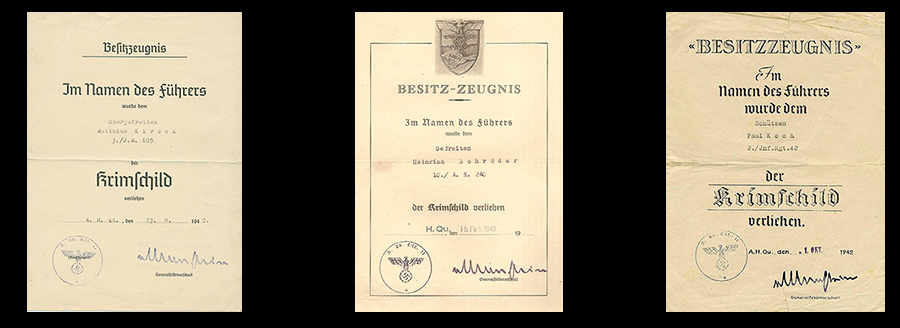
Of the many designs of document (both official and unit specific) that were produced for the Krim Shield, the three above are but a few

A member of a Panzer Regiment with the Crimea (Krim) Shield in wear
![]()
The Demyansk Battle Shield
(Der Demjanskschild)
The Demyansk Battle Shield ( Ärmelschild Demjansk) was instituted on 25th April, 1943 by Adolf Hitler for award to all military personnel who fought in the Demyansk pocket (Festung Demjansk) between the 8th February 1942 - 21st April 1942
Trapped in the pocket were the 12th, 30th, 32nd, 123rd and 290th infantry divisions, and the SS-Division Totenkopf, as well as RAD, Police, Todt organization and other auxiliary units, for a total of about 90,000 German troops and around 10,000 auxiliaries. Their commander was General der Infanterie Walter Graf von Brockdorff-Ahlefeldt, commander of the 2nd Army Corps.

A Junkers Ju 52, as part of the air-bridge, delivering much needed supplies in to the Demjansk pocket
Award Criteria
Requirements for Heer and auxiliary units included honorable service in the besieged area for 60 days or wound or frostbite in the besieged area.
For Luftwaffe - 50 combat or supply missions over the besieged and surrounding area.
Versions
Shield on field-gray wool backing for Heer (army) and Waffen-SS
Shield on gray-blue wool backing for Luftwaffe (air force)
Shield on black wool backing for Panzer units (armoured units)
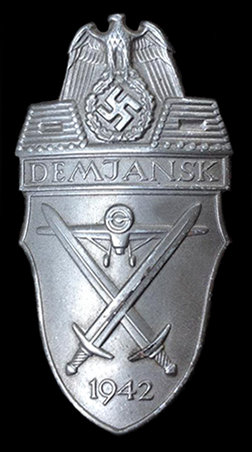
The Demjansk Battle Shield
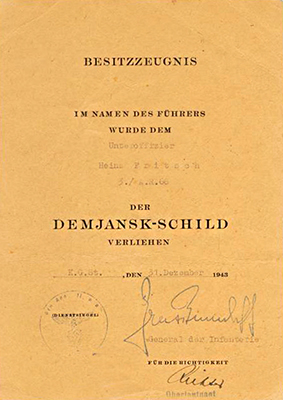
Typical document for the Demyansk Battle Shield
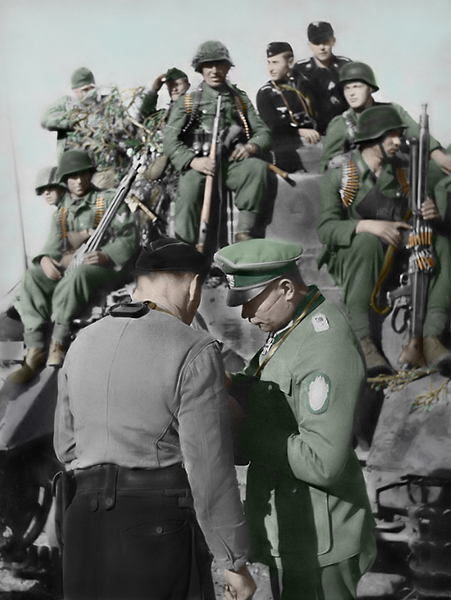
Officer with Demyansk Battle Shield in wear
![]()
The Kuban Battle Shield
(Der Kubanschild)
The Kuban bridgehead (Kuban-Brückenkopf), also known as Gotenkopf (Gothic head), was a German retreat position on the Taman Peninsula, which existed from January to October 1943. It had originally been held by the Germans after the retreat from the Caucasus to allow a new attack on the oil fields of the Caucasus. After the withdrawal of the German Army to the Panther-Wotan line, the troops located in the bridgehead were evacuated across the Strait of Kerch to the Crimea. The German 17th Army under the command of Generaloberst Richard Ruoff, later under the command of General der Pioniere Erwin Jaenecke, was tasked with the defense of the bridgehead.
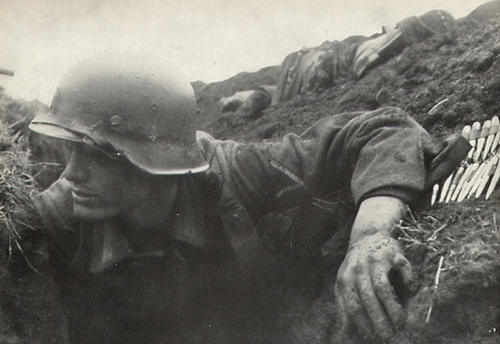
German defensive position at the Kuban bridgehead
The Kuban bridgehead was held despite repeated Soviet attacks during this period. This enabled the evacuation by sea, using the Marinefährprahm (naval ferry barge), of 239,669 soldiers, 16,311 wounded, 27,456 civilians and 115,477 tons of military equipment (primarily ammunition), 21,230 vehicles, 74 tanks, 1,815 guns and 74,657 horses to the Crimean peninsula. The Luftwaffe further evacuated from the bridgehead 15,661 men from an airfield at Slavyansk-na-Kubani. The withdrawal was one of the few military withdrawal operations of the Wehrmacht in which the entire Army Group and all its heavy equipment was not lost.
Instituted on the 20th September 1943, the Kuban Battle Shield (Kubanschild) was awarded to those who fought to preserve the bridgeheads in the Kuban region from February 1943 until they were abandoned in October.
Award Criteria
Personnel needed to have defended bridgeheads between February 1943 - October 1943.
To have served in the bridgehead for 60 days.
To have been wounded while defending the bridgehead.
To have been engaged in a single major operation at the bridgehead:
1.Battle of Krasnodar (1st-11th February 1943)
2.Defensive battles to prevent the Red Army outflanking the left wing of the army (1st February to 4th March 1943 and 26th to 31st March 1943)
3.Defensive actions against enemy landings at Novorossiysk (3rd to 28th February 1943)
4.Battle of Abin (12th to 1st February 1943)
5.Defence of the Troizkoje bridgehead (2nd to 8th March 1943)
6.Battle for Abinskaja (10th to 16th March 1943)
7.Defensive battle at Krymskaja with defense of Kurka front (4th to 18th April 1943)
8.Attack against Novorossiysk beachhead (17th to 20th April 1943)
9.Defensive battle at Krymskaja with simultaneous defense of the enemy attack in Novorossiysk (29th April to 10th May 1943)
10.Defensive battle at Krymskaja (26th May to 8th June 1943)
11.Defensive battle at Krymskaja with offensive and defensive battles in Neberdschajewskaja and defense of attacks on Kurka section (16th July to 13th August 1943)
12.Defence of the landing attack at Novorossiysk (10th May to 9th October 1943)
Versions
Shield on field-gray wool backing for Heer (army) and Waffen-SS
Shield on gray-blue wool backing for Luftwaffe (air force)
Shield on black wool backing for Panzer units (armoured units)
Shield on dark blue wool backing for Kriegsmarine (navy)
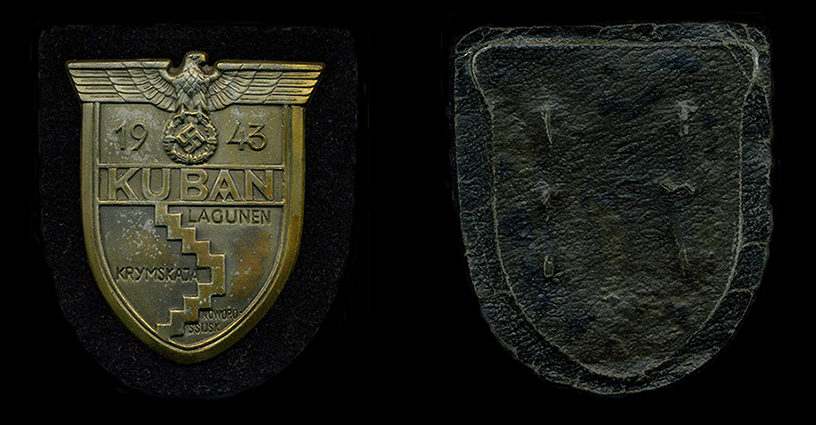
Kuban Battle Shield - Kriegsmarine (navy)
(Jody Beltram collection)
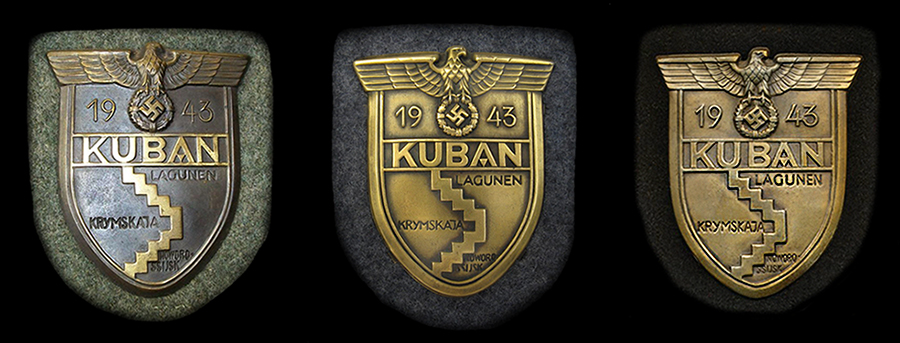
The Kuban Battle Shield - left: Heer (army) middle: Luftwaffe (airforce) right: Panzer (armoured units)
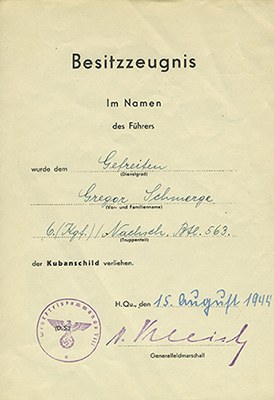
Document for the Kuban Battle Shield
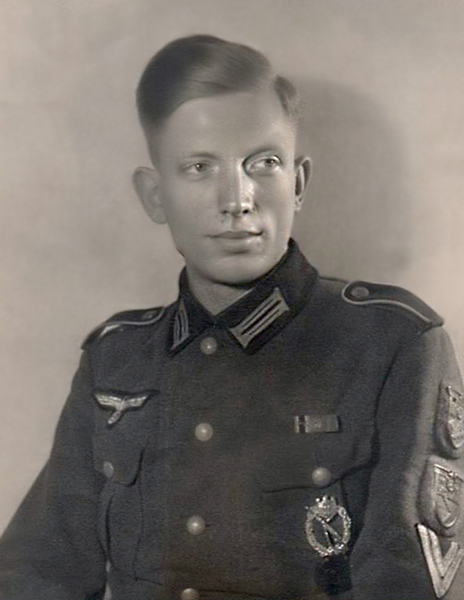
Kuban Battle Shield in wear
Interesting to note the wear of both Krim Campaign and Kuban Battle Shields as per regulations
![]()
The Warsaw Battle Shield
(Der Warschauschild)
The Shield was intended to be awarded to members of the Wehrmacht, Waffen-SS and auxiliary forces who participated in the suppression of the Warsaw uprising by the Free Polish Army between the 1st August and 4th October 1944.
Troops, under the command of SS-Obergruppenführer unf General der Polizie Erich von dem Bach-Zelewiski ,battled the free Polish army and used brutal force in putting down the rebellion. Two SS divisions in particular, the 29th Ukrainian volunteers under Bratislav Kaminski and the 36th under Dr Oskar Dirlewanger, committed such appalling acts that a few of the worst offenders were executed for discreditable conduct.
The Warsaw Battle Shield (Warschauschild), designed by Benno von Arent, was instituted on the 10th December 1944
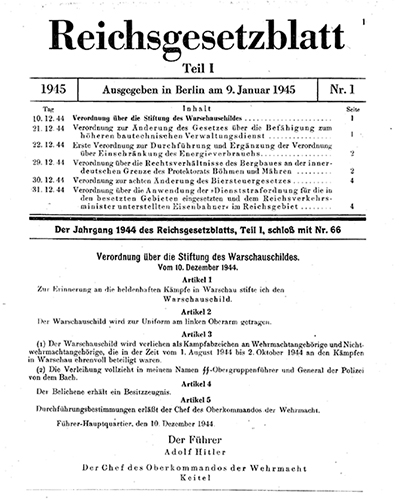
The decree confirming the institution of the Warsaw Battle Shield in the "Reichsgesetzblatt" dated 9th January 1945
Award Criteria
Heer (army) Waffen-SS
To have participated on a minimum of seven combat days
To have been wounded in the fighting
To have performed an act of bravery during the fighting
To have served for a period of 28 days in the combat zone in a support capacity
Luftwaffe (airforce)
To have flown 20 combat missions during the fighting
The Warsaw Battle Shield, like a number of awards instituted in the closing months of the war, never got past the design stages. However, a design matrix is said to have been struck prior to the Allied bombing that destroyed the dies that had been produced to strike the shields, so it is entirely possible that some shields were produced prior to the bombing.
whether the shield was awarded on paper will remain a question for future historians to answer... as, at present, there is little hard eveidence to support that it ever was.
The only reference that we have as to what the shield looked like are the two design drawings submitted by the designer, Benno von Arent, for approval.
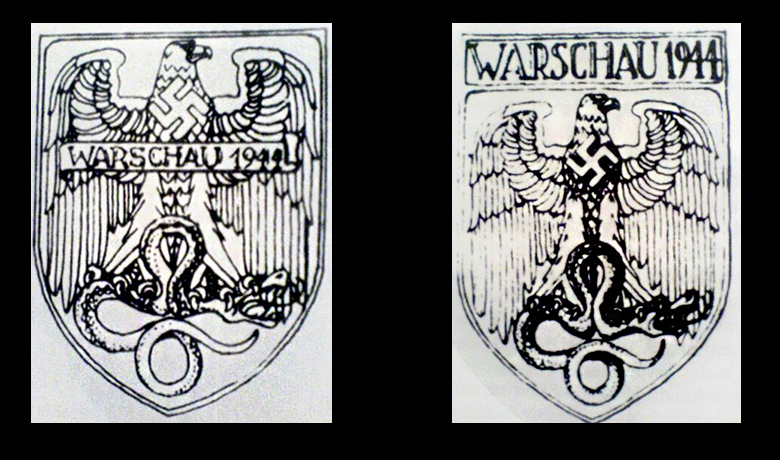
The design drawings for the Warsaw Battle Shield submitted by, Benno von Arent
The only other references that exist are the 101 fakes that are for sale, with the "story".
One of the better productions is the post-war produced Warsaw Battle Shield from "Souval"
Of course, for illustration purposes only

Post-war Warsaw Battle Badge by "Souval"

The Warsaw Ghetto 1945
"The city must completely disappear from the surface of the earth and serve only as a transport station for the Wehrmacht. No stone can remain standing. Every building must be razed to its foundation."
SS-Chief Heinrich Himmler - SS officer's conference
![]()
The Lappland Campaign Shield
(Der Lapplandschild)
The Lappland Shield (Lapplandschild) was created in February 1945, officially approved on the 1st May 1945 and was the last officially instituted German campaign shield of the war. It was awarded to those military personnel of General Franz Böhme's XX Mountain Army who had been fighting a two-front campaign against the advancing British and Soviet forces in Lapland between November 1944 and the war's end in May 1945.
Though the shield has been found to have been recorded into XX Mountain Army paybooks (soldbuch) as early as April, it is believed that no awards were actually presented at this time. However, after the cessation of hostilities the German forces in the area found that their captor, General Thorne, went against common practice and allowed his prisoners to wear their decorations. In light of this circumstance, the men of 20th Mountain Army began to produce the shield from whatever industry was available in the area. Examples of the shield have been found to have been constructed from a variety of metals including zinc, aluminium and tin.
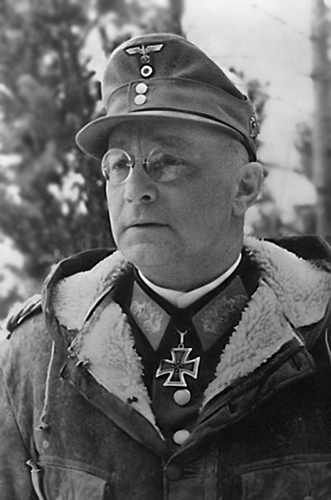
General Franz Böhme
Award Criteria
Served six months service in the area
Been wounded in the campaign
Attained a bravery award during the prescribed dates
Even though the award was presented after the end of the war, it should be considered an official award as it was authorized prior to the capitulation of the Wehrmacht.

Some of the variations of the Lappland Shield
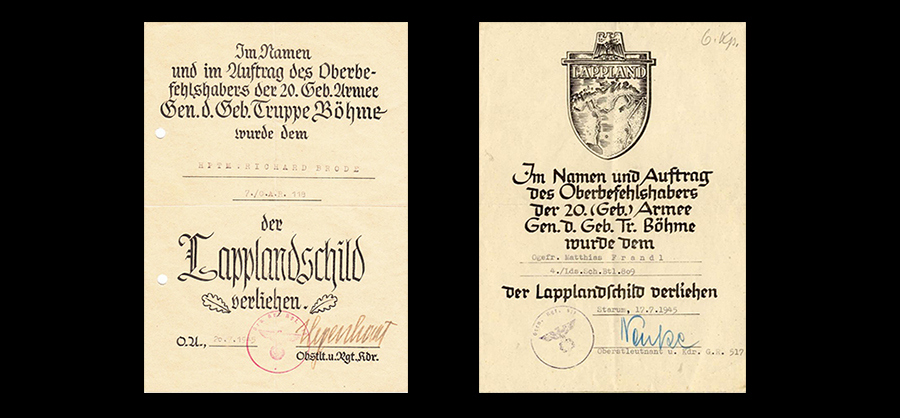
Two of the many variations of document for the Lappland Shield
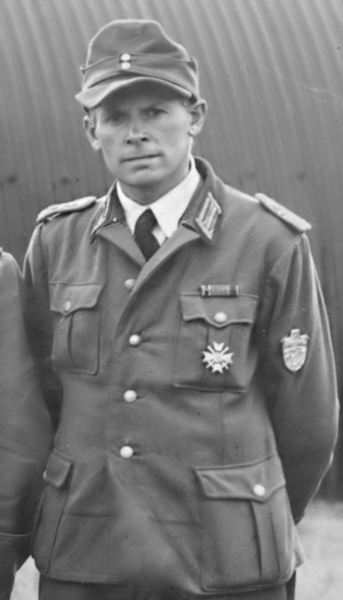
POW with Lappland Shield in wear
![]()
Unofficial Battle Shields
We now enter a rather grey area when it comes to these unofficial "shields".
Much, often contentious, debate has been going on over the years with regards to the circumstances surrounding these shields; whether the shields, considered as original, are in fact period artifacts or just fantasy, or if the shields were even awarded in any form.
The eveidence, such as it is, suggests that some sort of commemorative "shield" was locally produed for these "fortresses" (festungen) personnel, but in what form, and under what criteria still needs to be clarified by way of conclusive proof, which will one day hopefully emerge.
The Dunkirk Shield
(Der Dünkirchenschild)
The port of Dunkirk was cut off by the Allies after the breakout from the Normandy beachhead in the summer of 1944. Hitler gave orders that certain ports were to become fortresses (festungen) and were to hold out as long as possible, what ever the cost.
The Siege of Dunkirk occurred from September 1944 when units of the Second Canadian Division surrounded the heavily fortified city and port of Dunkirk. German units within the fortress withstood initial probing attacks, and as the opening of the port of Antwerp became a higher priority, the Allied commander, Montgomery, decided to merely contain the Germans within Dunkirk without attacking the fortified city. For this task, the 1st Czechoslovak Armoured Brigade was used.
The German garrison, made up from elements of the49th Infantry Division, 226th Infantry Division, 346th Infantry Division, 711th Infantry Division, 97th Infantry Division, 26th Fortress Battalion, 1046th Fortress Battalion, Waffen-SS group "Reinecke" and a mixed force of Navy and Luftwaffe troops numbering some 15,000 remained in Dunkirk until the general German surrender in May 1945.
On the 5th April 1945, Frisius launched Operation "Blücher" a raid in force against the enemy positions around his perimeter. The raid so surprised the British command that it blew all the bridges over the canals near the town. Although the Allies counterattacked under heavy air cover, they failed to dislodge the Germans from their newly established positions, making this action possibily the last German victory of WW2
The fortress, commanded by Vizeadmiral Friedrich Frisius, eventually surrendered unconditionally to Brigade General Alois Liška, the commander of the Czechoslovak brigade group, on the 9th May 1945
The Dunkirk Shield (Dünkirchenschild), which is believed to have been unofficially introduced and locally manufactured around the end of February 1945 for award to those troops who had participated in the defence of the port of Dunkirk, was not intended for wear on the sleeve, but for attaching to the side of the cap in much the same manner as the "Traditionsabzeichen" worn by U-boat crews; this borne out by an entry in an original Soldbuch (paybook) referring to the shield as a "Mützenabzeichen" (cap badge). Other entries found in paybooks, it has to be said, refer to it as the "Dünkirchenschild".
The number of shields awarded is unknown as no official documents have come to light. We do know that it was never recognized as an offical award as there is no mention of it in the "Gesetz über Titel, Orden und Ehrenzeichen" of 1957.

The Dunkirk Shield
(Interesting to note the incorrect German spelling of Dunkirk)
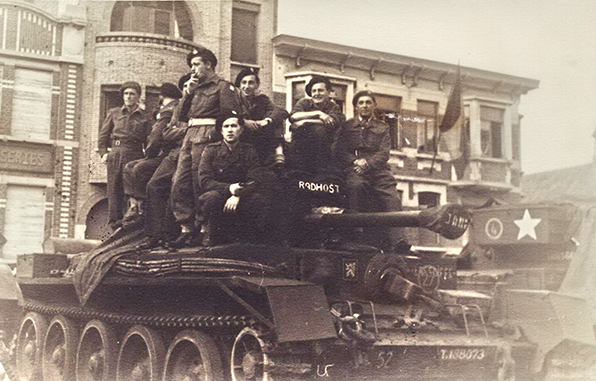
Czechoslovak soldiers on a Cromwell tank near Dunkirk just after the German surrender
![]()
The Lorient Shield
(Der Lorientschild)
The port of Lorient was of vital importance to the German maritime war effort, first coming into use in September 1942. At the beginning of 1943 Lorient was at its peak of its activity and there were as many as 28 U-boats (home to the 2nd and 10th U-boat Flotillas as well as the 14th Sub-Hunter Flotilla) at the base at the same time.
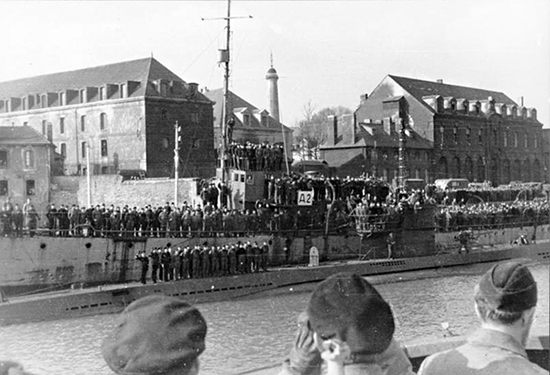
U123 - Lorient
It was eventually expanded to include three colossal submarine bunkers that included dry docks. As late as 1944 not everything had been completed as planned but Lorient was without doubt the largest and more intricate of all the U-boat bases in France. Of the 1,149 major U-boat overhauls in the French bases during the war, 492 were carried out in the Lorient dockyard.
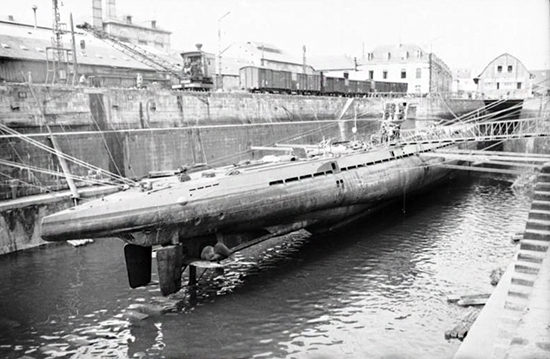
U37 in dry dock - Lorient
As with Dunkirk, Hitler ordered port of Lotient to Fortress (festung) status in readyness to prevent the Allies from re-supplying their armies after the invasion of France and to secure the continued use of submarines in the Battle of the Atlantic.
All personnel were ordered to fight to the last man
A mixed force of Army, Navy and Airforce, numbering approximately 25,000, under the command of General Der Artillerie Wilhelm Fahrmbacher successfully defended Lorient, and held out against repeated attacks from the 12th August 1944 until the German Surrender on the 10th May 1945
As to the shield; I will leave it up to one who is more knowledgeable in this area than I .
From the observations of the internationally renowned author and historian, Gordon Williamson.
"A shield to commemorate the defence of Lorient is said to have been designed by Marinebaurat Fehrenberg and submitted for approval to the base commander, Admiral Hennecke, who is said to have authorised its manufacture and issue some rime in late 1944. (It is worth noting, however, that when approached for information in the late 1970s, the admiral insisted that he had no knowledge of the existence of such an insignia).
The insignia, which has been illustrated below, consists of a tall, narrow shield bearing a helmeted naked warrior figure standing astride the Lorient U-boat pens, armed with a sword and oval shield, the latter bearing an eagle and swastika emblem. To either side of the helmeted head are '19' and '44'.
All sorts of tales have circulated about shields being made up in a local fish cannery using tinplate, and even that at least 50 per cent of the garrison received the insignia (a figure which would have required the theoretical manufacture of anything up to 24,000 examples). This certainly is not supported by the testimony of veterans, of which Admiral Hennecke's is perhaps the most significant.
A number of apparently genuine Soldbuch entries exist, however, which would suggest that some sort of commemorative award was received, whether or not it was the shield in question. A few shields also exist which have a provenance of sorts, which might suggest that they are genuine wartime originals. The shield may have been intended, and perhaps a few trial strikes were indeed made: but until verifiable evidence emerges to back up the theory of its production this version of the shield will continue to be regarded with considerable scepticism.
What is known for a fact, however, is that some troops of the garrison were issued with a commemorative piece, in the form of an identity disc blank stamped with the legend 'Festung Lorient 1944' using the standard numeral and letter die punches used to mark up regulation discs. Original examples of this type are known in private collections, some even still sewn on to the sleeves of the tunics of the original recipients. It is said that photographs exist of garrison personnel being marched into captivity in which this piece can be seen being worn."
As with the 'Dunkirk Shield', we know that any award to do with Lorient was ever recognized offically, as there is no mention of an award, of any kind in the "Gesetz über Titel, Orden und Ehrenzeichen" of 1957.

Lorient Shield
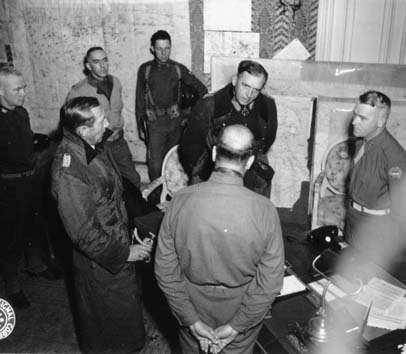
Admiral Walter Hennecke at the official surrender - Cherbourg 1945